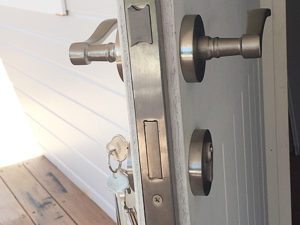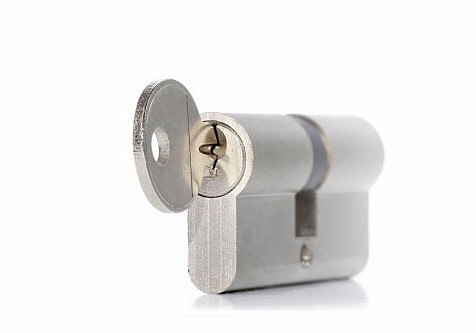A mortice lock is a lock that requires a pocket—the mortise—to be cut into the door or piece of furniture into which the lock is to be fitted. In most parts of the world, mortise locks are found on older buildings constructed before the advent of bored cylindrical locks. They have recently become more common in commercial and upmarket residential construction and are widely used in older domestic properties.

The installation of a mortise lock can be undertaken by persons with a good working knowledge of woodworking tools and methods, however many builders are using KC’s Northern Beaches Locksmiths because the installation is time consuming, and needs to be neat and accurate, for strength and aesthetics.
A cylindrical lock usually has a short plate around the latch bolt, and the body of a cylindrical lock is installed through the face of the door.
A mortice lock can be identified if you look at the side of a door and there is a long plate around the latch bolt. The lock body is installed into a pocket (the mortise) cut into the side of the door.

Mortise locks have a range of benefits, and are available in a range of different lock functions – many more than cylindrical locks offer.
Mortise locks actually weaken the structure of the typical timber door, making it important to cut out the smallest possible pocket, to house the lock body.
The mortice lock is more versatile than a bored cylindrical lock both in external trim, and functionality. Whereas the latter mechanism lacks the architect required for ornate and solid-cast knobs and levers, the mortise lock can accommodate a heavier return spring and a more solid internal mechanism.
Mortise locks also come in a variety of design options, from sleek stainless steel to antique, rustic to contemporary. They have a larger selection of trims and roses than you do with cylindrical locks, allowing architectural conformity with lock hardware already on site.
They are generally more expensive than cylindrical locks.
Mortise locks may include a non-locking sprung latch operated by a door handle. This type of lock is termed a passage lock. A simpler form without a handle or latch is termed a ‘dead lock’. Dead locks are commonly used as a secure backup to a sprung non-deadlocking latch.
Mortise locks more commonly use lever locks as a mechanism.
The parts included in a typical mortise lock installation are:
1. the lock body (the part installed inside the mortise cut-out in the door);
2. the lock trim (which may be selected from any number of designs of doorknobs, levers, handle sets and pulls; a strike plate or a box keep, which lines the hole in the frame into which the bolt fits;
3. the keyed cylinder which operates the locking/unlocking function of the lock body. However, in some countries, mortise locks on dwellings do not use cylinders, but have lever mechanisms which are operated by the larger mortice key. (commonly referred to as the gaol type key)

Installations of mortice locks can become problematic and costly. It involves patience and precision to ensure a final product customers can be proud of.
The thickness of the timber prior to the glass is important.
The door thickness will determine the hardware required or if customised hardware is required.
The door type will effect the hardware
It is helpful to know the customers current and future keying requirement prior to the installations.
There are a variety of backsets available. It is helpful to know of current or future backset requirements.
This is more about convenience than security. It may be best to replace old or broken locks. Re-pinning the locks to new keys will bring them back to working easily, rather than having to lift or jiggle the keys, to make them function.





